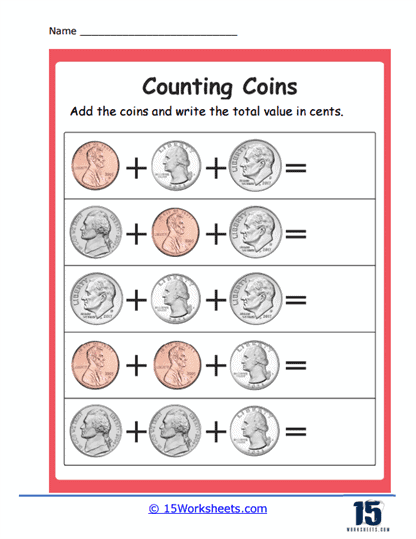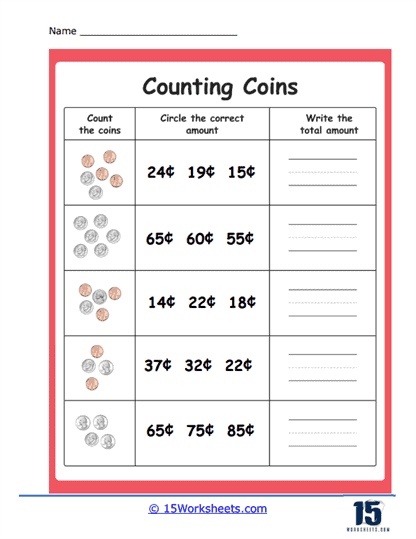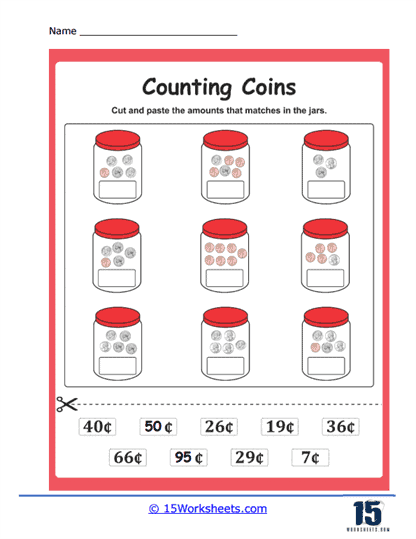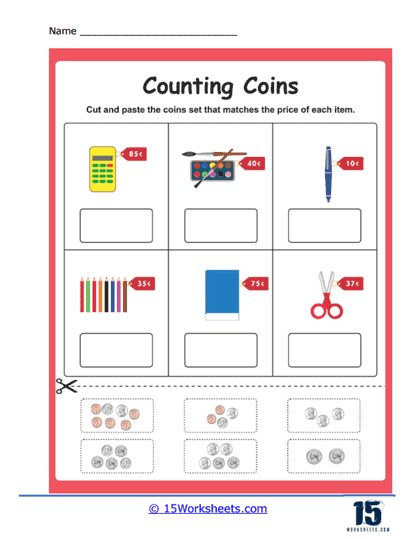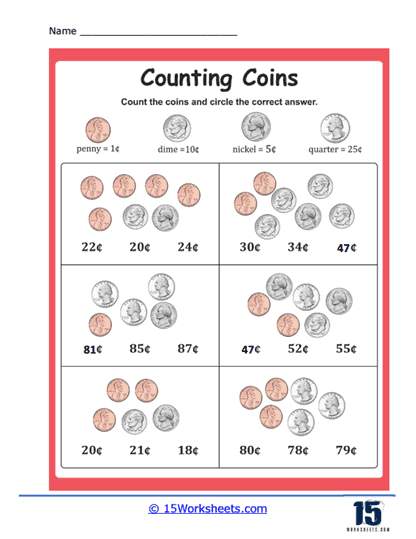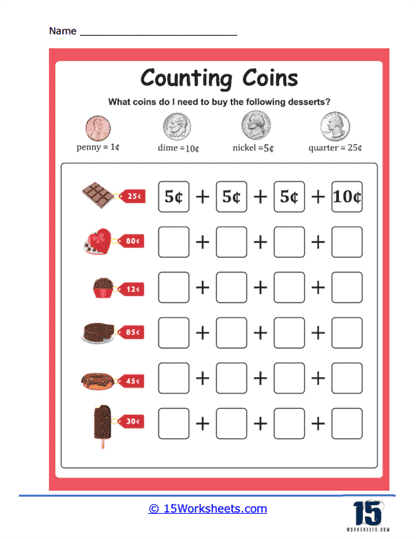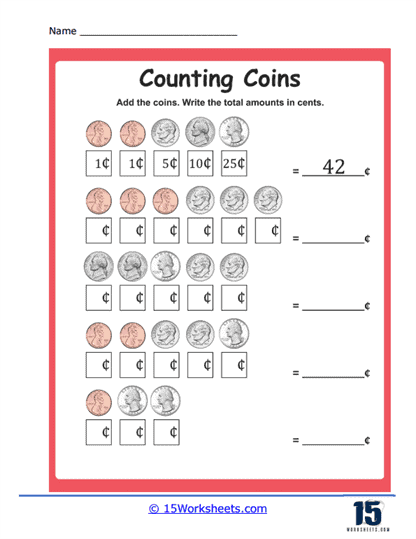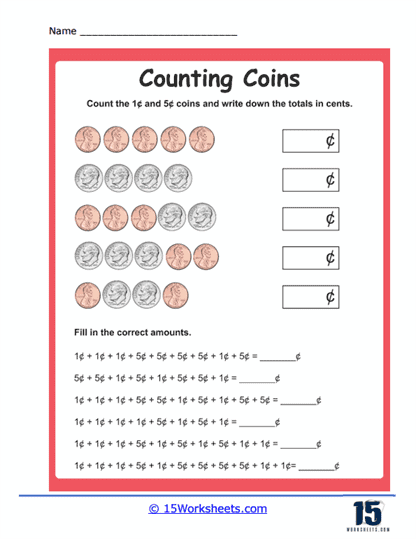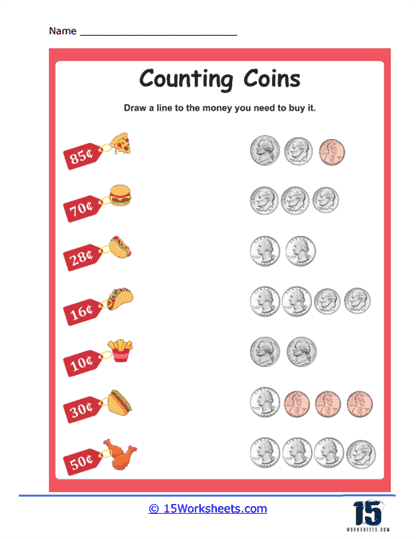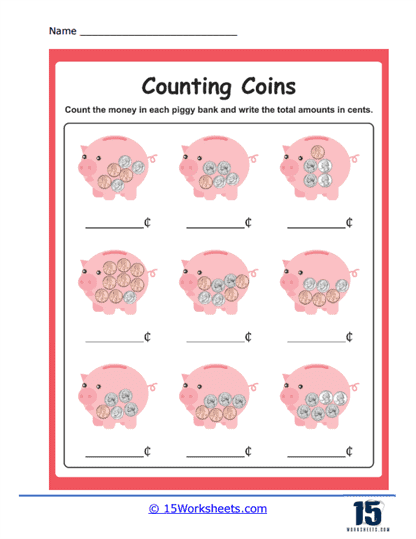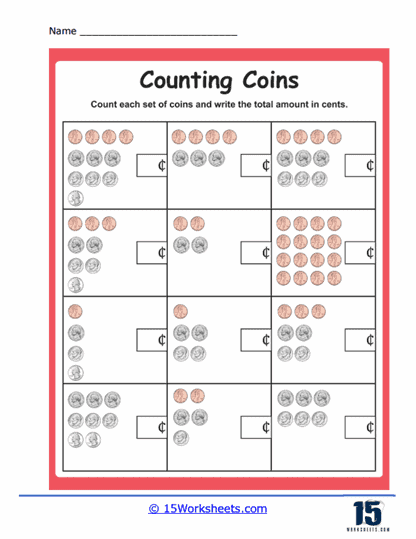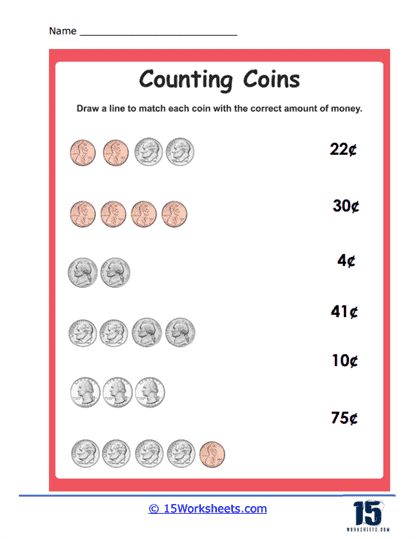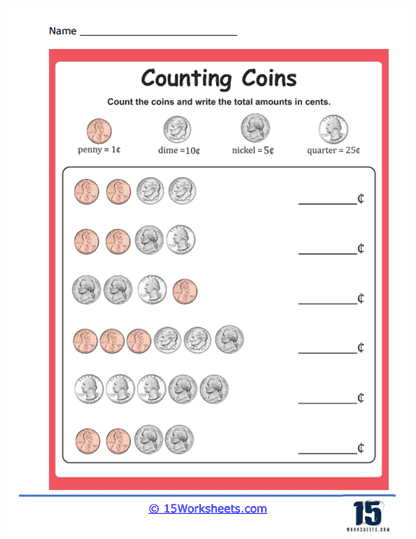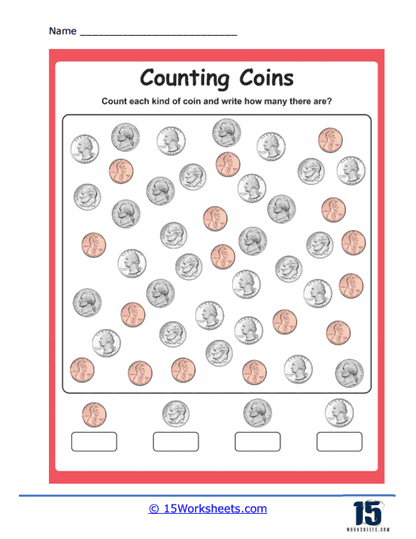Counting Coins Worksheets
About These 15 Worksheets
These worksheets will enhance students’ understanding and proficiency in managing and calculating with coins, a fundamental aspect of currency and financial literacy. These worksheets encompass a variety of exercises tailored to different age groups and learning stages, from recognizing coins to complex operations involving money. Practicing with these worksheets not only solidifies basic mathematical skills but also prepares students for real-world financial transactions.
The diverse exercises found on these worksheets cater to a range of learning needs, from basic coin recognition to complex financial planning and problem-solving. Regular practice with these worksheets not only enhances students’ mathematical skills but also prepares them for real-life financial situations, fostering financial awareness, responsibility, and independence. As students progress through these exercises, they develop critical thinking, problem-solving, and decision-making skills, which are essential for academic success and effective participation in the economy. The benefits of practicing with Counting Coins Worksheets underscore the importance of integrating financial literacy into early education, equipping students with the knowledge and skills needed to navigate the financial aspects of their lives confidently.
Types of Exercises
Coin Identification – This foundational exercise introduces students to different coins, such as pennies, nickels, dimes, quarters, half-dollars, and sometimes dollar coins in the U.S. context. It involves matching coins to their names and values, helping students become familiar with each coin’s physical characteristics and worth.
Value Calculation – Once students can identify coins, the next step involves calculating the total value of a group of coins. These exercises require students to add different coin values together, promoting basic addition skills and the concept of equivalent values (e.g., five pennies equal a nickel). Understanding that different combinations of coins can equal the same value is crucial. Worksheets may ask students to find all the possible combinations of coins that equal a given amount, enhancing their ability to think flexibly about money and its value.
Making Change – More advanced worksheets may present scenarios where students must determine the correct change from a purchase. This type of exercise enhances subtraction skills and practical understanding of transactions, encouraging students to think about the most efficient way to give change using the fewest coins.
Comparing Values – Exercises that involve comparing sets of coins to determine which has a higher or lower value foster critical thinking and decision-making skills. These tasks may include using symbols like <, >, and = to compare totals, reinforcing mathematical concepts of comparison and inequality.
Budgeting Exercises – Advanced worksheets might include budgeting exercises where students allocate a set amount of money to purchase items within a budget. This type of task introduces basic financial planning and prioritization skills. Integrating coins into word problems bridges the gap between abstract math and real-life application. These problems require students to apply their knowledge of coins in narrative contexts, solving for total costs, change required, or money saved, thereby honing their problem-solving skills.
The Benefits of These Worksheets
Practicing with Counting Coins Worksheets offers a myriad of benefits that extend far beyond mere familiarity with currency. These benefits collectively contribute to a student’s academic, cognitive, and real-world skill set, laying a foundation that is essential for both academic success and daily financial interactions.
The regular use of these worksheets significantly enhances numeracy skills. By engaging in exercises that require addition, subtraction, and calculations with different denominations, students develop a foundational competence in mathematics. This skill is not only crucial for academic success in math but also plays a vital role in understanding financial literacy from a young age. The ability to perform basic calculations with ease is a stepping stone to more complex mathematical concepts and everyday financial management.
These types of worksheets play a crucial role in developing financial awareness among students. Through transaction-based exercises and change-making scenarios, students gain a hands-on understanding of the value of money and its practical applications. This early exposure to financial concepts is essential, as it cultivates responsible money management habits that students will carry into adulthood. Learning to navigate financial transactions with confidence prepares them for the realities of the economic world, instilling a sense of financial responsibility from a young age.
The diverse exercises found in these worksheets also significantly improve problem-solving skills. Students are challenged to apply their mathematical knowledge in a variety of contexts, from simple calculations to complex real-world scenarios. This not only enhances their ability to solve problems creatively and efficiently but also fosters a mindset geared towards analytical thinking and solution finding. Such skills are indispensable, both in academic settings and in everyday life, where problem-solving capabilities are constantly called upon.
Preparation for real-life financial transactions is another invaluable benefit of practicing with these worksheets. The skills gained through these exercises equip students with the knowledge necessary for making accurate calculations, providing the correct change, and understanding the intricacies of purchasing scenarios. This practical knowledge is crucial for navigating the world of commerce, where financial transactions are an everyday occurrence. By mastering these skills early on, students are better prepared to handle their finances effectively and make informed decisions in various purchasing situations.
The requirement to compare values, understand equivalences, and solve word problems within these worksheets facilitates critical thinking and analysis. These cognitive processes are essential for academic success across various disciplines and are equally important in navigating life’s challenges. The development of critical thinking skills through financial literacy exercises ensures that students are well-equipped to analyze situations, make comparisons, and arrive at informed conclusions in both their academic pursuits and daily decision-making.
Learning the importance of budgeting, saving, and making informed financial decisions from a young age is crucial for establishing healthy financial habits. These skills are the pillars of financial health, enabling students to manage their resources wisely, plan for the future, and avoid common financial pitfalls. By instilling a sense of financial responsibility early on, we prepare students not only for personal financial success but also for contributing positively to the economic well-being of society.

